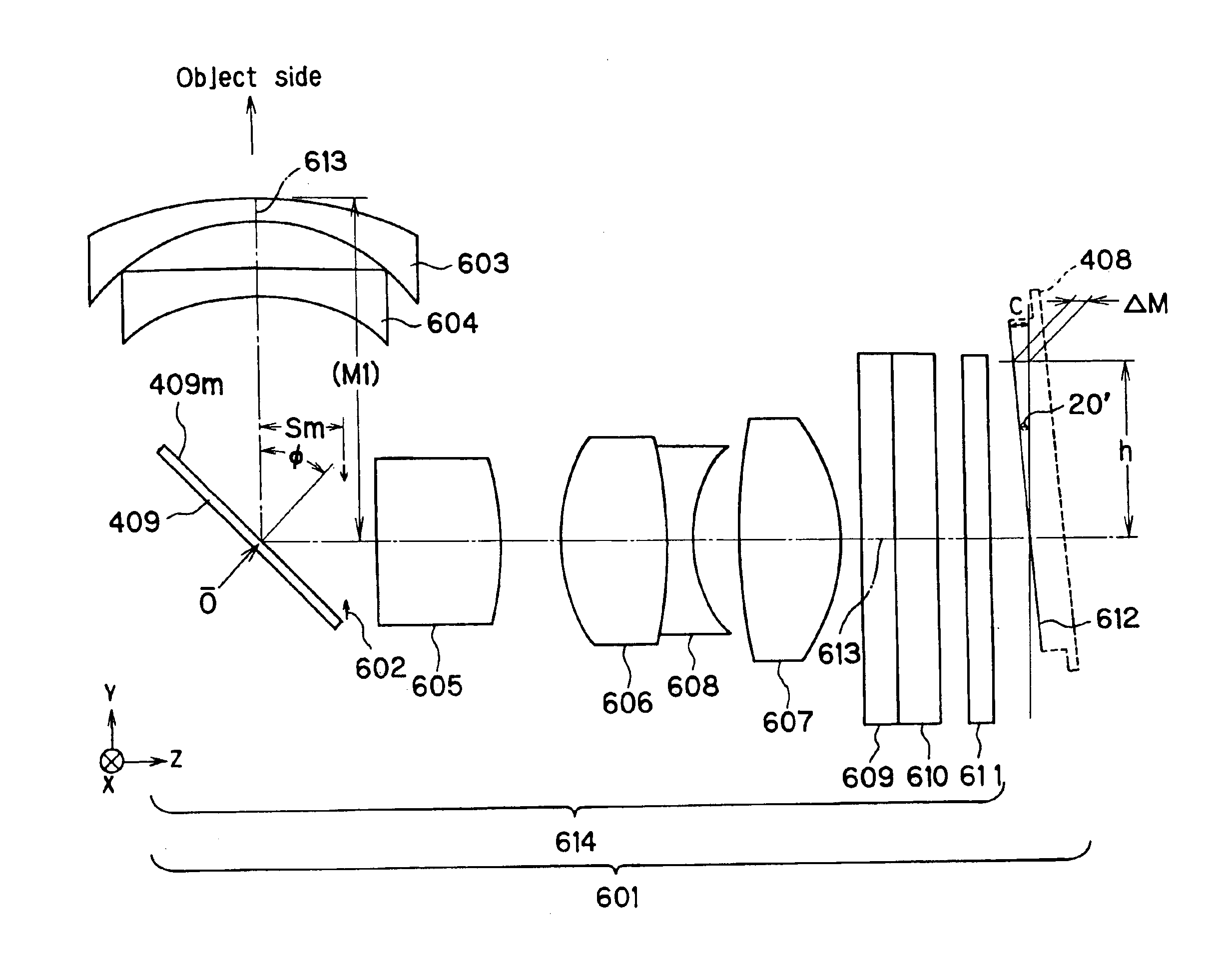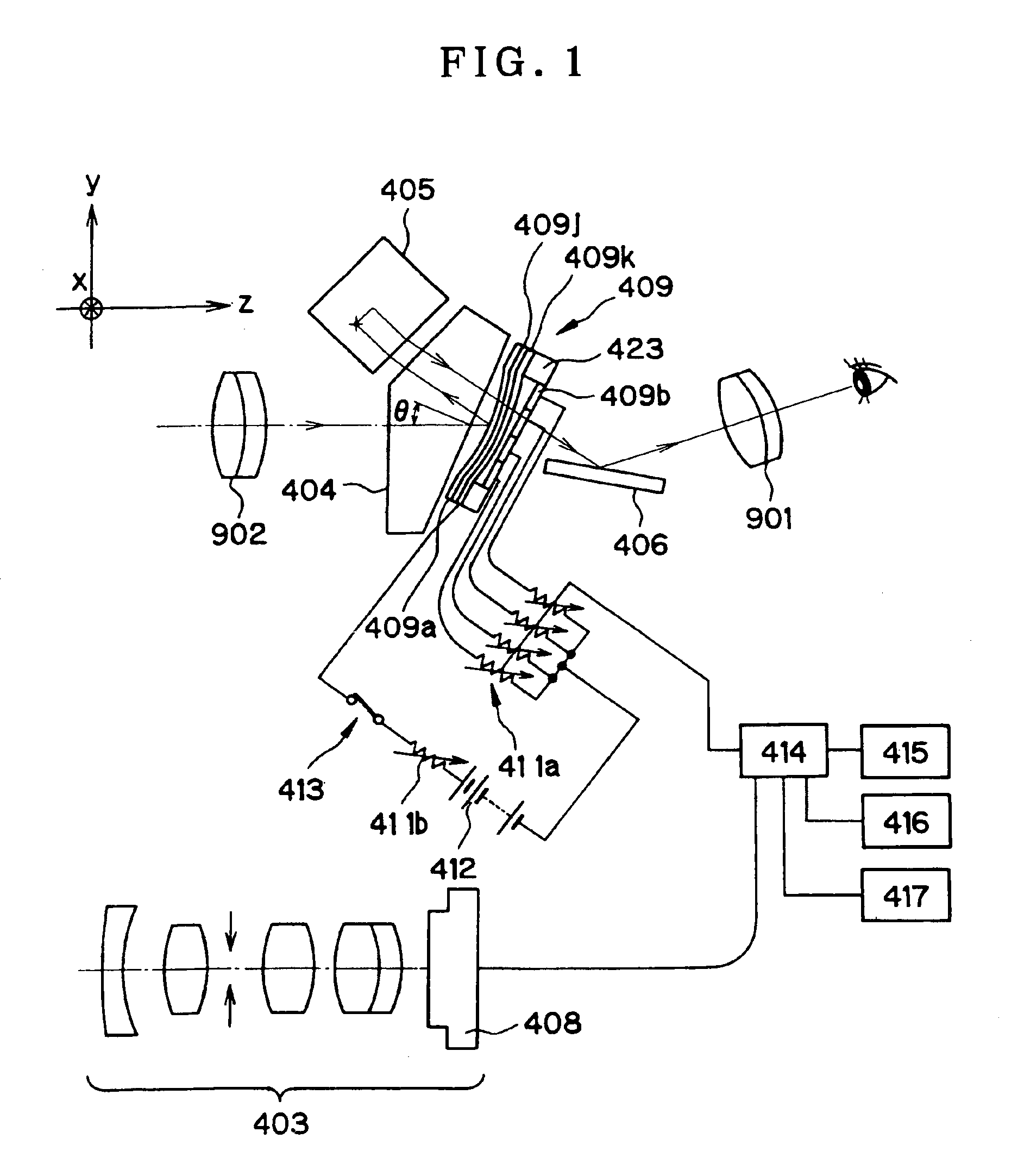Optical system, and optical apparatus
a technology of optical system and optical apparatus, applied in the direction of printers, instruments, camera focusing arrangement, etc., can solve the problems of increased power consumption, inability to vary the focal length of the lens, complicated mechanical structure, etc., and achieve the effects of reducing power consumption, reducing noise, and reducing nois
- Summary
- Abstract
- Description
- Claims
- Application Information
AI Technical Summary
Benefits of technology
Problems solved by technology
Method used
Image
Examples
embodiment 1
[0408]This embodiment is directed to an image pickup optical system 614 in which the optical system of FIG. 39 is used, as shown in the Y-Z sectional view of FIG. 45. As shown in FIG. 45, the respective optical elements are located in order from the object side of the optical system. The first two elements are negative meniscus lenses 603 and 604, each convex on its object side, in the rear of which there is located a variable mirror 409. In the rear of the variable mirror 409, there are located a stop 602, then a double-convex positive lens 605 having an aspheric surface on its image side, then a doublet consisting of a double-convex positive lens 606 and a double-concave negative lens 608, and finally a double-convex positive lens 607 having an aspheric surface on its image side. In the rear of the positive lens 607, there are located a low-pass filter 609, then an infrared cut filter 610, and finally a cover glass 611, in the rear of which there is located an image pickup surface...
embodiment 2
[0411]This embodiment is the same in lens arrangement as Embodiment 1. As shown in the Y-Z sectional view of FIG. 46, the respective optical elements are located in order from the object side of the optical system. The first two elements are negative meniscus lenses 603 and 604, each convex on its object side, in the rear of which there is located a variable mirror 409. In the rear of the variable mirror 409, there are located a stop 602, then a double-convex positive lens 605, then a doublet consisting of a double-convex positive lens 606 and a double-concave negative lens 608, and finally a double-convex positive lens 607. In the rear of the positive lens 607, there are located a low-pass filter 609, then an infrared cut filter 610, and finally a cover glass 611, in the rear of which there is located an image pickup surface 612 of a solid-state image pickup device, which is tilted at an angle C of tilt with respect to a plane vertical to an optical axis 613 at an object distance ∞...
embodiment 3
[0414]The image pickup optical system of this embodiment is much the same in lens arrangement as that of Embodiment 1. As shown in the Y-Z sectional view of FIG. 47, in order from the object side of the image pickup optical system there are located a negative meniscus lenses 603 and 604, each convex on its object side. In the rear of the lens 604, there is located a variable mirror 409 that also serves as an aperture stop. In the rear of the variable mirror 409, there are located a positive meniscus lens 605 convex on its image plane side, then a doublet consisting of a double-convex positive lens 606 and a double-concave negative lens 608 and finally a double-convex positive lens 607. In the rear of the lens 607, there are located a low-pass filter 609, then an infrared cut filter 610 and finally a cover glass 611. In the rear of the cover glass 611, there is located an image pickup surface 612 of a solid-state image pickup device. In the image pickup optical system, lens systems c...
PUM
 Login to View More
Login to View More Abstract
Description
Claims
Application Information
 Login to View More
Login to View More - R&D
- Intellectual Property
- Life Sciences
- Materials
- Tech Scout
- Unparalleled Data Quality
- Higher Quality Content
- 60% Fewer Hallucinations
Browse by: Latest US Patents, China's latest patents, Technical Efficacy Thesaurus, Application Domain, Technology Topic, Popular Technical Reports.
© 2025 PatSnap. All rights reserved.Legal|Privacy policy|Modern Slavery Act Transparency Statement|Sitemap|About US| Contact US: help@patsnap.com



